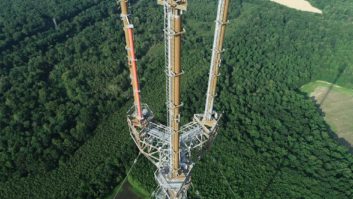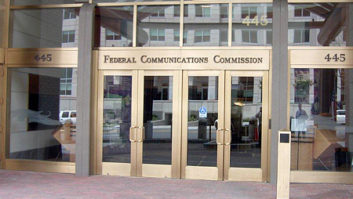WASHINGTON — The FCC is considering making adjustments to the rules governing Travelers’ Information Stations.
On the table are requests from some highway groups and TIS stations themselves to increase their power levels and widen the types of programming the low-wattage AM stations can air.

This TIS road sign sits along northbound I-75 in Michigan’s Lower Peninsula leading to the Mackinac Bridge. Photo courtesy Mackinac Bridge Authority The commission is considering requests from three different groups for modifications to existing TIS rules in a Notice of Proposed Rulemaking. In the proposal, the agency asks what kinds of limits it should impose on TIS stations, if it does in fact expand their capabilities.
Low-power TIS stations, licensed to federal, state and local governmental entities, are only allowed to transmit travel-related information. Specifically, TIS stations can broadcast voice information pertaining only to traffic and road conditions, traffic hazard and travel advisories, directions, historical and event information and descriptions of local points of interest.
Some TIS operators would like to include such things as Amber alerts, terror threat levels, NOAA weather forecasts, public health warnings and other information.
The 10-watt radio stations, most often found at 530 kHz, air advisories directly to motorists and are located near major auto travel routes, airports, parks or transportation terminals. The FCC established the TIS service in 1977 and authorized them on a primary basis on 530 kHz and on a secondary basis in the 535–1705 kHz band. Transmitting antennas cannot exceed 49.2 feet in height.
The U.S. National Park Service is one of the largest users of TIS systems, while the California Department of Transportation operates a system of 120 fixed TIS locations and another 12 mobile TIS facilities throughout the state.
The FCC estimates there are 1,300 TIS stations on the air in the United States. Stations typically can be heard in a three- to five-mile radius of the station’s antenna.
It’s not 1977 anymore
The groups requesting updates are the American Association of State Highway and Transportation Officials; the American Association of Information Radio Operators; and Highway Information Systems. Each submitted petitions asking for varying degrees of modifications.
Eric Ehrenreich, attorney advisor in the FCC’s policy division of the Public Safety and Homeland Security Bureau, said the bureau chose to combine the individual petitions into one NPRM.
“The commission is seeking comment on the specific changes to the TIS rules proposed by each petitioner and on the overall approach the FCC should take,” the FCC states in the notice.
The three petitioners contend that conditions have changed since the commission initiated the TIS service in 1977 and that the expansion of some of the rules would be in the public interest.
Highway Information Systems’ petition asked the commission to consider renaming the TIS service the “Local Government Radio Service” and eliminate the limitation that confines TIS stations to areas near roads, highways and public transportation terminals. In its petition, the group proposes that TIS stations be permitted to transmit information as determined by the government entity licensed to operate the station.
Highway Information Systems is a subsidiary of Vaisala, Inc., a Swedish firm that specializes in road weather monitoring systems. It purchased Highway Information Systems in 2009 from Quixote Corp.

Mike Kattich from Century Electric and Tom Coviak from Information Station Specialists install electronics and route services for a TIS station in Aurora, Ill. Photo courtesy Information Station Specialists Several of the petition groups asked the FCC to consider allowing use of “ribbon systems,” in which several transmitters in close proximity broadcast the same material to cover a larger geographic area. Current rules preclude government entities from creating networks of stations.
American Association of State Highway and Transportation Officials asked the FCC to consider allowing Amber alerts and 511 service information on TIS facilities.
William Baker, president of American Association of Information Radio Operators, said his group believes the TIS service can be more valuable for public safety.
“Helpful content is out there now that was not envisioned by the original writers of the rules. Amber alerts, for example, were not available in 1977 when the TIS rules were adopted. The question is whether such critical content should be disseminated widely by all media but excluded from TIS.”
Baker and his group, which has 335 members, contend that public safety is everyone’s business. “Just because someone is seated behind the wheel of a car does not mean that they suddenly cease to have an interest in their greater safety.”
Radio World’s attempts to reach the other two petitioners for comment were unsuccessful.
Michael Williams, president of the Wildlands Residents Association-San Marcos Pass Volunteer Fire Department in Santa Barbara, Calif., manages a TIS station near State Road 154, where 11,500 motorists pass its location each day.
Wildfire advisories
“Changes in FCC regulations to provide a broader base of information would be helpful, particularly rebroadcasting of NOAA information directly from NOAA. We also get asked a lot, particularly by local emergency officials, about increasing our coverage area.”
Williams said since wildfire is the number one public safety threat in the area, it’s critical for his TIS station to be allowed to carry advisories from the U.S. Forest Service.

Information Station Specialists’ Field Tech Tom Coviak installs a Travelers Information Station. Photo courtesy Information Station Specialists TIS proponents often argue that the stations could benefit the public even more, especially during power blackouts, when traditional means of communication are inoperable. According to the FCC, a significant number of TIS stations operate on solar power or have backup systems that would allow them to continue operations.
“The FCC has an interest in promoting policies that will enhance the effectiveness of public alerts and warning reaching motorists over diverse communication channels,” the FCC states in the NPRM.
In addition to increased content, the commission invites public comment on whether TIS field strength limits should be modified to increase coverage areas and whether to allow stations in more locations.
At least one broadcast consulting firm questions the soundness of any power increase for TIS stations, citing concerns about increased clutter on the AM band, and especially nighttime skywave interference.
“Any increase in power level and increase in the number of TIS facilities is obviously going to increase the noise level, or the noise floor in the AM band, especially during nighttime hours,” said Ben Dawson, president of Hatfield & Dawson Consulting Engineers. “Nighttime skywave propagation is so variable that any increases in signal will likely raise the noise level.”
Commercial broadcasters at first opposed creation of the TIS in the mid-1970s, claiming that it would duplicate information provided by commercial broadcasters, the FCC wrote in the NPRM. However, those issues were settled when the commission ordered that TIS services be non-commercial and low-power, experts said.
Still, the NAB, in comments on the petition for rulemaking filed by American Association of Information Radio Operators in 2009, said there was insufficient evidence to justify a major overhaul of TIS operations and therefore asked that the petition be denied.
Others, including National Public Radio, have voiced similar reservations about changing the TIS rules, arguing that the service is accomplishing what it was intended to do.
“The FCC must ask itself whether there is a compelling need to recast the existing TIS service and if doing so will merely duplicate existing and emerging broadcast services,” NPR said in comments filed in response to the petitions for rulemaking.
The FCC’s Ehrenreich said bureau staff will review public comments and make recommendations to the full commission, which will ultimately decide whether to modify the rules by issuing a Report and Order.
Reply comments to PS Docket No. 09-19 are due by March 7; initial comments were due by Feb. 18.










